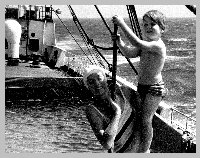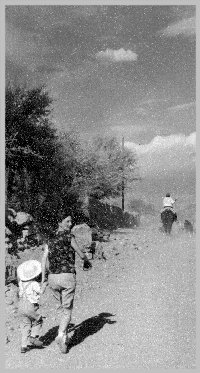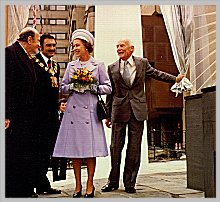| | | | |

|
|
The Family
|
|
In 1959 Fleischmann married Joy and in 1961 their son Dominique was born. This represented a major event
in the sculptor's life and much of the subject matter of his work revolves around the theme of the family.
|

|
|
Dominique and Joy on the Cotopaxi
|
|
Through the many commissions for the Pacific Steam
Navigation Company, he was able to arrange several ocean voyages.
|

|
|
Dominique and Joy in Chile
|
|
|
He and his family travelled together on long sea
passages on board cargo ships belonging to the company. One of the most notable
trips was an Atlantic crossing on the Cotopaxi to South America.
|
|
In 1968 MGM released the Stanley Kubrick film "2001 - A Space Odyssey". The mysterious monolith that
landed on earth was originally commissioned by Kubrick from Stanley Plastics. At two tonnes
it was the largest block of acrylic ever cast. Mr Stanley delivered the block to Boreham Wood
Studios, but Kubrick was disappointed with screen tests and the sparkling clear polymer block
was eventually rejected as a prop in favour of dense, black basalt that was imported from Scandinavia.
|

|
|
HM Queen Elizabeth II unveiling
|
|
'The Crystal Crown'
|
|
The block was not abandoned, however, and resurfaced nine years later in the form of a glittering
sculpture entitled "The Crystal Crown", hand-carved by the Arthur Fleischmann. The sculpture was
made to celebrate the Silver Jubilee of Queen Elizabeth II and was unveiled by the Queen herself
in June 1977 in St. Katherine's Docks, London, where for three months Fleischmann had patiently
chiselled away at the block inside a polythene tent.
|
|
In 1969 Fleischmann was commissioned to create a sculpture for the British Pavilion at
Expo70, Osaka, Japan. He was developing concepts in Water Sculptures constructed from horizontal
sheets of Perspex over which water was allowed to trickle. He decided to embark on designing and
creating a huge version of a sketch he had shown the architects. It was entitled "Harmony and Progress",
was twelve feet high and graced the main entrance of the Pavilion.
It was typical of Fleischmann that he persuaded the organising committee to pay for his wife and son
to travel to Osaka with him while supervising the installation on site. |

|
|
'Harmony and Progress'
|
|




